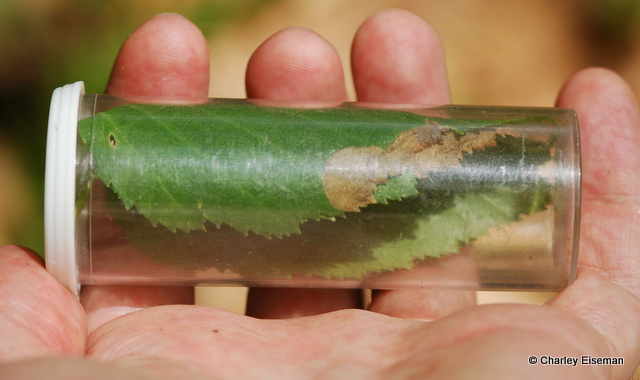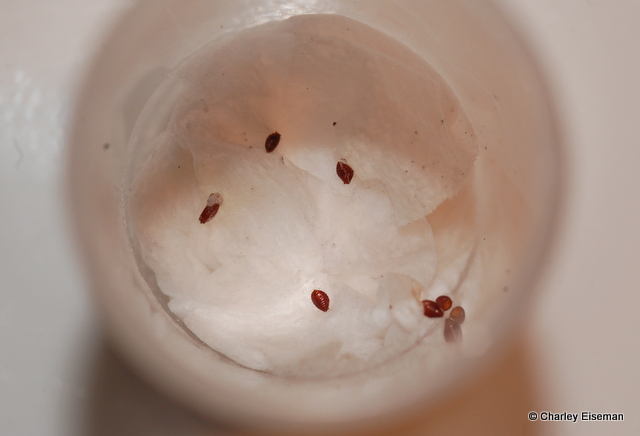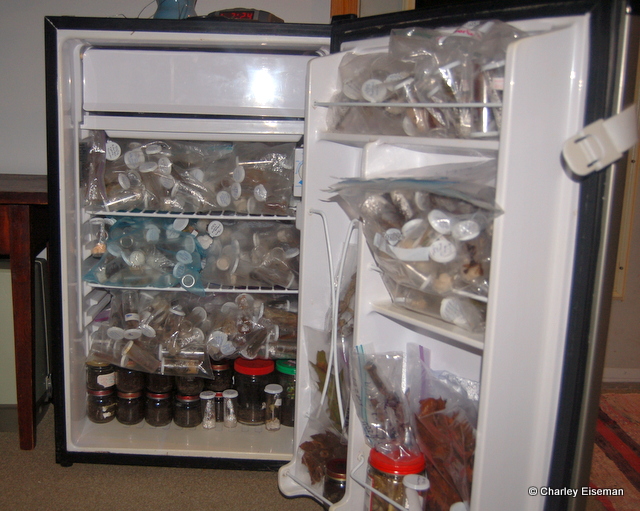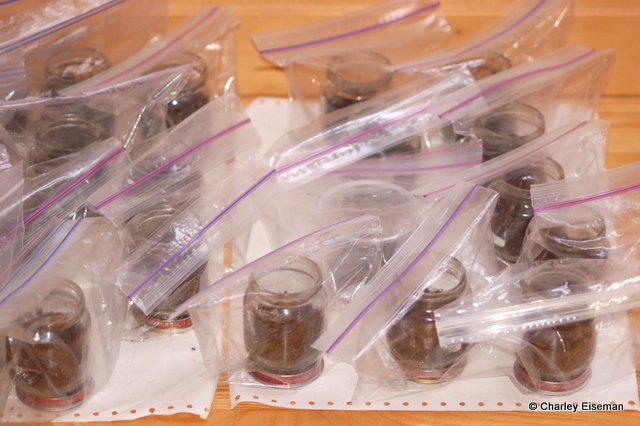I am often asked about my methods for rearing insects, so rather than keep repeating myself I’ve created this page to refer people to. If you have any questions after reading it, feel free to leave a comment here and I will do my best to answer it.
I collect leaf mines, galls, etc. in standard insect vials (plastic, snap-cap, usually 9- or 15-dram; sometimes larger ones or old peanut butter jars, etc., for leaves / plant parts that won’t fit in the small vials). You can get them from Thornton Plastics or Ecology Supplies; if anyone has suggestions of other places to buy them, I’d be happy to add them here. In a pinch, any container that is airtight, is not too big to maintain proper humidity, allows you to see inside, and doesn’t have crevices where tiny insects could hide, should work fine for rearing. I use a Sharpie pen to write the date, location, and host plant on the lid; this is easily washed off later with alcohol or soap and water when I want to reuse the vial for something else.

These vials do a good job of retaining the humidity from the leaves, and often nothing more than this needs to be done for a leafminer to complete its development. There is plenty of air in there for an insect to breathe, so no need to punch holes or anything like that. If the leaves (or other host material) are too large to fit in a vial, I put them in a jar or a Ziploc type bag, but if possible it’s best not to complete rearings in bags because adult insects are likely to injure themselves when they emerge (for instance, moths rub off their wing scales, or other insects may deform their wings by cramming themselves into a tight corner).
Some leafminers pupate in the leaves, and in this case you can just wait until the adult emerges. If the leaf starts to dry out (or to prevent a leaf from drying out), I crumple up a square of toilet paper, stuff it in the bottom of the vial, and add a squirt or two of water from an eyedropper. A plastic bag can similarly be humidified with a lightly dampened, folded-up paper towel. For agromyzid flies and certain other things that exit the plant material before pupating, I move the pupae or puparia to a fresh vial with a fresh piece of moistened, crumpled toilet paper. I move puparia from one container to another using a fine-pointed paintbrush; before picking up each one I dip the paintbrush in water. If the larva has spun a cocoon on the vial itself, I leave it in place, removing the plant material to prevent mold and then adding the tissue paper if there wasn’t some already.

A vial is optimally humid when you can see the slightest amount of fogging on the sides. The vial in the above photo is excessively humid. I use a paper towel to wipe excess moisture from the sides of vials; otherwise there is a risk of the newly emerged adult getting stuck in a water droplet and either drowning or not having its wings expand properly. In the photo below, we’re looking down into the same vial, which contains six puparia of the buckeye-mining agromyzid.

I check vials once a day to see if anything has emerged or if any humidity or mold control is needed. Many leafminers will emerge as adults within a month or so. These buckeye flies do not emerge until the following spring, and the same is true of a number of other insects whose larvae are only active in spring. Species with this kind of life cycle obviously take a little more dedication to rear, and it’s important to check the vials regularly and add drops of water if the tissue starts to dry out. If the tissue starts to get moldy, I transfer the puparia to a fresh vial with a fresh piece of tissue. Erik van Nieukerken uses moss instead of tissue for rearing nepticulids, heliozelids, and other moths. This reduces the mold problem (I’m told), but has the disadvantage of potentially introducing predators, pathogens, or other contaminants to the vial.
Any insects that need to overwinter will need to be exposed to cold temperatures. Their containers could be put in an unheated shed or garage, out of direct sunlight, but then you need to check during warm spells to see if anything is emerging. I like to put everything away for the winter and forget about it, so I use a refrigerator. As far as I know, no insects need to be exposed to freezing temperatures to complete their development, but they need to be exposed to temperatures just above freezing for a certain amount of time. I generally put everything in around November 1 and take everything out around March 1. For a small number of vials or jars, just putting them somewhere in the back of the food fridge would do, but I have a little bug-dedicated fridge in my basement for this purpose. Here’s what it looked like just before I took everything out this spring:

The fridge is mostly filled with vials in gallon Ziploc bags. In the lower half of the door, you can see a few bags containing larger leaves. On the bottom shelf of the fridge are baby food jars and peanut butter jars containing soil. This brings me to my rearing method for insects other than agromyzid flies that exit their mines or galls to pupate (or are free-living to begin with). Some insects spin a cocoon aboveground, and these I handle in the same way as agromyzid flies. Others (e.g. eriocraniid moths, gall midges, anthomyiid flies, most sawflies, and many weevils and chrysomelid beetles) burrow into soil to pupate. For these, I put a moistened 50/50 mixture of peat and sand in a jar, 3-4 cm deep. The peat helps keep the soil fluffy and its acidity prevents mold from growing. I normally wait until the larvae are mature and wandering around in their original rearing vials before transferring them to a jar of soil, but if I won’t be able to check regularly because of traveling, etc., I put the leaves or galls on top of the soil in the jar, then remove them when I see that the larvae have exited.
The photo below shows a peanut butter jar containing a noctuid caterpillar feeding on a sprig of wintergreen that I’ve “planted” in the peat/sand mixture. These caterpillars take a few months to become full-grown, and I add fresh sprigs of wintergreen as needed. They burrow into the soil when they’re finished feeding and emerge as adult moths about two months later.

As I already illustrated in my grasshopper post, I take the lids off of the soil jars and put them in Ziploc bags so I can see when adults have emerged. This method, incidentally, is based on the method Ray Gagné has developed for rearing gall midges. I think he has now switched to using 100% peat.

For groups such as eriocraniids that I know won’t emerge as adults until the following spring, I keep the lids on the jars until I remove them from winter refrigeration. Lidded jars usually retain their moisture well, but those in plastic bags may need a few squirts of water from an eyedropper every once in a while. Because I’m worried about moths rubbing off their scales in plastic bags, when I have a baby food jar with soil containing eriocraniid larvae, I take the lid off of it and put it in an upside-down peanut butter jar.

For the wintergreen moths, I just leave the lid on the peanut butter jar, but have to check under the lid every day because this is likely to be where the moth comes to rest when it emerges.
If I’m not sure what an insect’s pupation habits are, I put it in a jar of soil with a piece of crumpled-up tissue paper on top of the soil. Almost all insects will either burrow into the soil or make a cocoon in the tissue or on the soil surface. Some sawfly larvae need a chunk of punky wood to burrow into; Dave Smith recommends providing pieces of cork for this purpose. There is an introduced leafminer on honeysuckle, Perittia herrichiella (Elachistidae), that I had a hard time rearing until I learned that it makes a cocoon on the bark of its host plant, camouflaged with bits of bark. So last fall I put some strips of honeysuckle bark in a vial and added the larvae as they emerged from their mines. The cocoons were so well camouflaged that the larvae just seemed to disappear after I put them in the new vial, but sure enough this spring they’ve all emerged as adults.
I think this pretty well covers it, but I’ll be happy to add further details if anything needs clarification. If anyone has had success with other rearing methods, I’d be interested to hear about them. I’ve done very little with wood-boring and stem-boring insects, for instance, and obviously some different strategies would be needed for these.




I’ve had bad luck rearing slug moth caterpillars (Limacodidae)–both times I tried they spun cocoons but no adults ever emerged. I asked Sam Jaffe what his method is, and here is his reply:
“I haven’t had too much trouble with them. Two strategies: fridge in closed Tupperware containers. Very limited moisture (a single drop) or else mold becomes a big problem, especially for Phobetron cocoons with the attached tentacles. In the spring remove and spray every so often, increase heat and moisture if not emerging under room temps/conditions. I’ve had cocoons just sitting around for ages and have only had eclosions after re-sealing them in containers with moisture and putting in warmer environment.
“Second strategy is to leave the cocoons sleeved outside with leaf litter protection. Can have 100% success like this. Has been great 2 out of 3 years. But can fail 100% if too cold/exposed. Adding leaf litter/insulation may help.
“I usually try both methods.”
Pingback: Introducing Fenusa julia | BugTracks
Hi Charley, I hope your year is progressing well.
I took my jars and vials out of the fridge a few weeks ago, and found many had moldy leaves. My question: When do you give up on a specimen and toss everything? Some critters may yet emerge, so I am still hanging on the the messes. I’ve had two pyralid moths emerge, but so far, nothing else.
Hi Chris– I find that most things emerge within two months of removing them from refrigeration. As to when I decide it’s time to give up, it depends on what I know about the species. There are some that you have to keep for a year before adults emerge, but these are mostly species that are active in the spring, and adults emerge within a few weeks after taking out of the fridge. This year I took everything out on April 1, and I had several adults emerge as recently as May 27 (all from larvae collected in September and October). I’m definitely getting to the point where I’m ready to do a big reduction of the number of vials I’m monitoring, but I’ll probably hang onto some of them for several more weeks. Hope that helps!
Yup. Any movement from the red oak unidentified species circular mines. None from my end.
No, for the second year in a row I collected a big bag of them and nothing emerged (found them on white oak this time around). No idea what the problem is.
This may be a rather unconventional question, but what leafminer groups tend to make the best captive “pet” specimens in your experience? I understand that many species are short-lived, small, or have long diapauses and other unappealing traits to the insect culturist. Anything that is around the size of a “typical” coccinellid and is interesting to watch over short timescales (not houseplant-speed) is probably welcome.
Thanks
Interesting question… The hispine leaf beetles (Chalepini) might be a good fit; they’re pretty easy to rear because the larvae are able to enter new leaves if the original ones deteriorate (or get used up), and they have a short pupal period, plus you could keep the adults for a while because they feed on leaves of the larval hostplant. The larvae take a couple of weeks to finish feeding, and they’re even a bit bigger than coccinellids.
Clarification: insects much bigger than the average lady beetle are welcome as well. Do you have any other suggestions?
Thanks again
I assumed that was what you meant. There are many moth and fly leafminers that are fairly easy to rear, and that don’t develop too slowly or too quickly, but nothing is jumping to mind as more interesting than the rest. You might check out the casebearers (Coleophora spp.)–their lifestyle is certainly unique.
Thanks for the advice. I am researching the Chalepini right now, but I am not sure how uninteresting your “many moth and fly leafminers” are. How “watchable” are the larvae and adults to if one sits down at a desk and observes them when they are awake?
I imagine a caterpillar, maggot, or fly would be interesting enough for my purposes if the insect is sufficiently active and perhaps follows a complex pattern of navigation to patrol its equally complex mine or dances about with other conspecifics to guard its ever-changing territory.
Yes, I didn’t mean to suggest that they were uninteresting, just that I find them all pretty much equally interesting so it’s hard to come up with something specific to suggest. The smaller the larvae are, the more you’ll want a dissecting scope to watch them through. With magnification it’s really cool to watch them chewing away. I’ve seen a time-lapse video of a nepticulid in which it was really striking how it moved its tail end around to place its frass pellets in a perfect zigzag pattern; I haven’t watched them in real time but I think you could still see it happening. Adults other than beetles may be less interesting to watch since they don’t feed on the leaves and will mostly just be trying to fly away. If you rear the flies out, it’s definitely interesting to watch the adults emerge from their puparia though. And adults of Caloptilia and some related moths twirl their long antennae around when at rest; I always get a kick out of that. Some rock their bodies from side to side while doing so.
Wonderful! I will now eagerly make plans for miner-hunting.
Speaking of “mostly trying to fly away”…
http://www.roachforum.com/index.php?/topic/7374-flight-cages/
I might be guilty of self-promotion, but I think you’ll find the discussion useful. Perhaps ideas developed from it could help entomologists study behaviors like aerial courtship.
By the way, have you seen this link on rearing woodborers?
https://beetlesinthebush.wordpress.com/2014/03/11/entomology-101-how-to-rear-wood-boring-beetles/
I may have, but haven’t had a chance to take a close look at it yet. Definitely a good link to have from this page.
Pingback: Spring Sparkler | BugTracks
Thanks for this guide! I’ve recently been observing the spot damage from Meunieriella on Smilax. We have several species of woody Smilax on the MS Gulf Coast, and all have this insect in great abundance, so it’s frustrating to me that it hasn’t been described to species (or maybe there’s more than one sp). It’s winter now and I don’t see the perpetrator, but somewhere on the bugguide.net site I believe you said the larva feeds from the outside of the leaf, so presumably it has finished feeding and is gone. I will start watching for it in the spring, but any tips you can give on collecting or rearing (beyond what’s in this blog) would be appreciated, and if I do ever get an adult, whom should I contact?
The midge that forms the maple leaf spots, Acericecis ocellaris, feeds from the outside of the leaf, but most spot galls (including the Smilax ones) are made by larvae feeding internally. In the Smilax ones you have to look at the underside of the leaf because the larva is just beneath the lower epidermis. I’ve only reared the Meunieriella once (using exactly the methods described above); as you can see here I collected the larva in Connecticut in early June, and the adult emerged from my jar of soil the following spring. So there is just one generation in New England; it’s conceivable that there are multiple generations in Mississippi, but I have no way of knowing. I would definitely recommend focusing your search on the first few weeks after the plants have leafed out. Besides that one specimen I reared, the only ones in existence are the one(s) Ray Gagné has reared (probably collected in the DC area). So part of the reason this species hasn’t been described is that there are so few specimens (and these weren’t available until recently), and part of it is that there are more species of gall midges than any other animal group on Earth and Ray is essentially the only person working on them in North America. I’m sure he would welcome more specimens, and if you got them from various species of Smilax he could investigate whether there are different midge species on the different host species. He may also be able to tell something by studying larvae from different hosts–it would be worth asking him if he’d like to see larvae from the various Smilax species.
Thank you! I will follow up.
Pingback: Willow Stem Galls | BugTracks